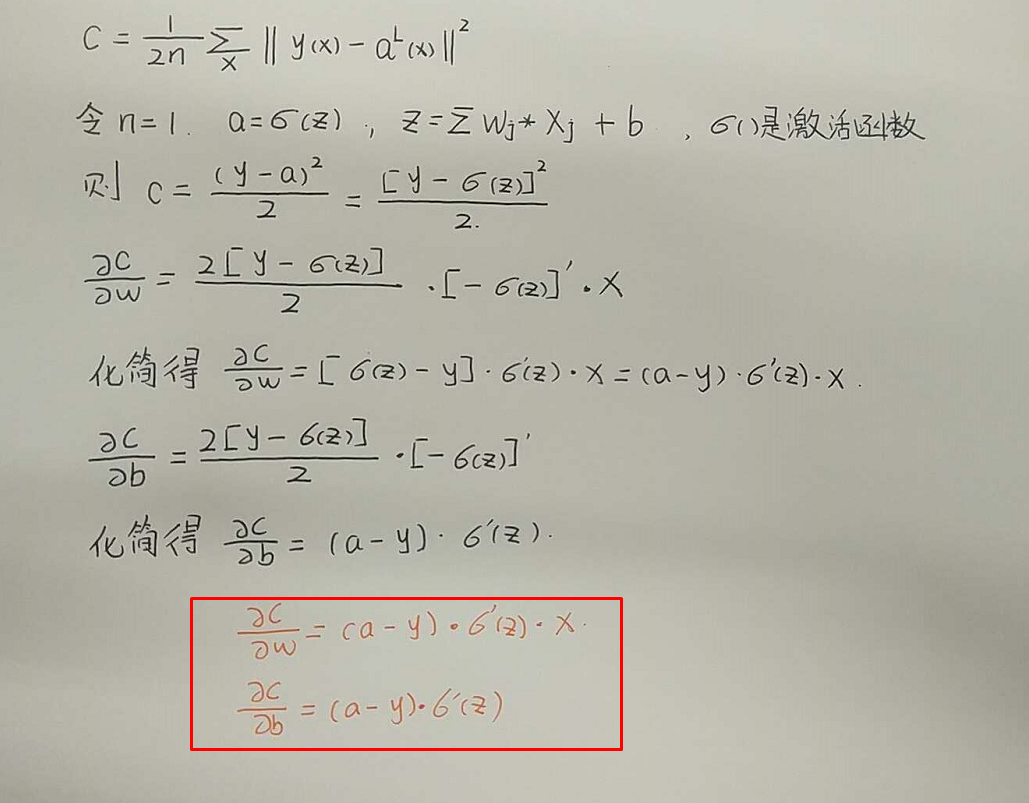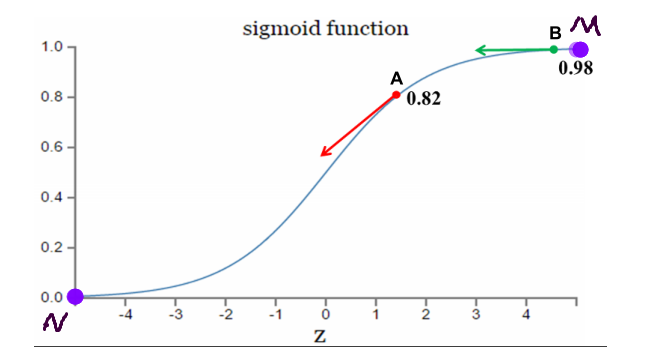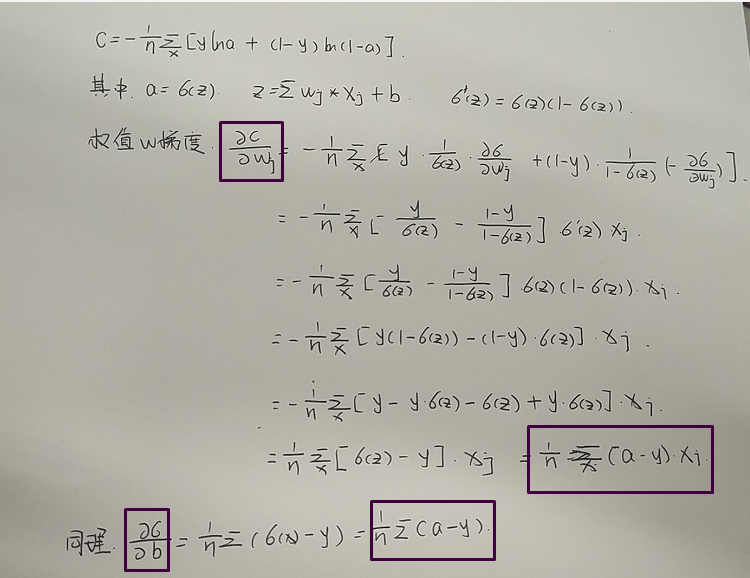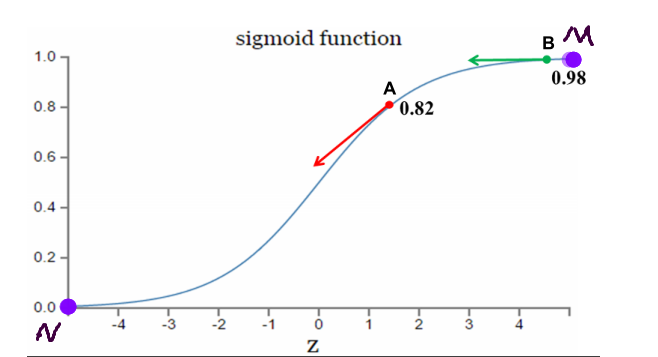机器学习与Tensorflow(3)—— 机器学习及MNIST数据集分类优化
一、二次代价函数
1. 形式:

其中,C为代价函数,X表示样本,Y表示实际值,a表示输出值,n为样本总数
2. 利用梯度下降法调整权值参数大小,推导过程如下图所示:

根据结果可得,权重w和偏置b的梯度跟激活函数的梯度成正比(即激活函数的梯度越大,w和b的大小调整的越快,训练速度也越快)
3. 激活函数是sigmoid函数时,二次代价函数调整参数过程分析

理想调整参数状态:距离目标点远时,梯度大,参数调整较快;距离目标点近时,梯度小,参数调整较慢。
如果我的目标点是调整到M点,从A点==>B点的调整过程,A点距离目标点远,梯度大,调整参数较快;B点距离目标较近,梯度小,调整参数慢。符合参数调整策略
如果我的目标点是调整到N点,从B点==>A点的调整过程,A点距离目标点近,梯度大,调整参数较快;B点距离目标较远,梯度小,调整参数慢。不符合参数调整策略
二、交叉熵代价函数
1.形式:

其中,C为代价函数,X表示样本,Y表示实际值,a表示输出值,n为样本总数
2. 利用梯度下降法调整权值参数大小,推导过程如下图所示:

根据结果可得,权重w和偏置b的梯度跟激活函数的梯度无关。而和输出值与实际值的误差成正比(即误差越大,w和b的大小调整的越快,训练速度也越快)
3.激活函数是sigmoid函数时,二次代价函数调整参数过程分析

理想调整参数状态:距离目标点远时,梯度大,参数调整较快;距离目标点近时,梯度小,参数调整较慢。
如果我的目标点是调整到M点,从A点==>B点的调整过程,A点距离目标点远,误差大,调整参数较快;B点距离目标较近,误差小,调整参数较慢。符合参数调整策略
如果我的目标点是调整到N点,从B点==>A点的调整过程,A点距离目标点近,误差小,调整参数较慢;B点距离目标较远,误差大,调整参数较快。符合参数调整策略
总结:
- 如果输出神经元是线性的,选择二次代价函数较为合适
- 如果输出神经元是S型函数(sigmoid函数),选择交叉熵代价函数较为合适
- 如果输出神经元是softmax回归的代价函数,选择对数释然代价函数较为合适
二、利用代价函数优化MNIST数据集识别程序
1.在Tensorflow中代价函数的选择:
如果输出神经元是线性的,选择二次代价函数较为合适 loss = tf.reduce_mean(tf.square())
如果输出神经元是S型函数(sigmoid函数),选择交叉熵代价函数较为合适 loss = tf.reduce_mean(tf.nn.sigmoid_cross_entropy_with_logits())
如果输出神经元是softmax回归的代价函数,选择对数释然代价函数较为合适 loss = tf.reduce_mean(tf.nn.softmax_cross_entropy_with_logits())
2.通过代价函数选择对MNIST数据集分类程序优化
#使用交叉熵代价函数
import os
os.environ['TF_CPP_MIN_LOG_LEVEL'] = ''
import tensorflow as tf
from tensorflow.examples.tutorials.mnist import input_data
#载入数据集
mnist = input_data.read_data_sets('MNIST_data', one_hot=True)
#每个批次的大小(即每次训练的图片数量)
batch_size = 50
#计算一共有多少个批次
n_bitch = mnist.train.num_examples // batch_size
#定义两个placeholder
x = tf.placeholder(tf.float32, [None, 784])
y = tf.placeholder(tf.float32, [None, 10])
#创建一个只有输入层(784个神经元)和输出层(10个神经元)的简单神经网络
Weights = tf.Variable(tf.zeros([784, 10]))
Biases = tf.Variable(tf.zeros([10]))
Wx_plus_B = tf.matmul(x, Weights) + Biases
prediction = tf.nn.softmax(Wx_plus_B)
#交叉熵代价函数
loss = tf.reduce_mean(tf.nn.softmax_cross_entropy_with_logits(labels=y, logits=prediction))
#使用梯度下降法
train_step = tf.train.GradientDescentOptimizer(0.15).minimize(loss)
#初始化变量
init = tf.global_variables_initializer()
#结果存放在一个布尔型列表中
correct_prediction = tf.equal(tf.argmax(y, 1), tf.argmax(prediction, 1)) #argmax返回一维张量中最大的值所在的位置,标签值和预测值相同,返回为True
#求准确率
accuracy = tf.reduce_mean(tf.cast(correct_prediction, tf.float32)) #cast函数将correct_prediction的布尔型转换为浮点型,然后计算平均值即为准确率 with tf.Session() as sess:
sess.run(init)
#将测试集循环训练20次
for epoch in range(21):
#将测试集中所有数据循环一次
for batch in range(n_bitch):
batch_xs, batch_ys = mnist.train.next_batch(batch_size) #取测试集中batch_size数量的图片及对应的标签值
sess.run(train_step, feed_dict={x:batch_xs, y:batch_ys}) #将上一行代码取到的数据进行训练
acc = sess.run(accuracy, feed_dict={x:mnist.test.images, y:mnist.test.labels}) #准确率的计算
print('Iter : ' + str(epoch) + ',Testing Accuracy = ' + str(acc))
#执行结果
Iter : 0,Testing Accuracy = 0.8323
Iter : 1,Testing Accuracy = 0.8947
Iter : 2,Testing Accuracy = 0.9032
Iter : 3,Testing Accuracy = 0.9068
Iter : 4,Testing Accuracy = 0.909
Iter : 5,Testing Accuracy = 0.9105
Iter : 6,Testing Accuracy = 0.9126
Iter : 7,Testing Accuracy = 0.9131
Iter : 8,Testing Accuracy = 0.9151
Iter : 9,Testing Accuracy = 0.9168
Iter : 10,Testing Accuracy = 0.9178
Iter : 11,Testing Accuracy = 0.9173
Iter : 12,Testing Accuracy = 0.9181
Iter : 13,Testing Accuracy = 0.9194
Iter : 14,Testing Accuracy = 0.9201
Iter : 15,Testing Accuracy = 0.9197
Iter : 16,Testing Accuracy = 0.9213
Iter : 17,Testing Accuracy = 0.9212
Iter : 18,Testing Accuracy = 0.9205
Iter : 19,Testing Accuracy = 0.9215
#使用二次代价函数
import os
os.environ['TF_CPP_MIN_LOG_LEVEL'] = ''
import tensorflow as tf
from tensorflow.examples.tutorials.mnist import input_data
#载入数据集
mnist = input_data.read_data_sets('MNIST_data', one_hot=True)
#每个批次的大小(即每次训练的图片数量)
batch_size = 100
#计算一共有多少个批次
n_bitch = mnist.train.num_examples // batch_size
#定义两个placeholder
x = tf.placeholder(tf.float32, [None, 784])
y = tf.placeholder(tf.float32, [None, 10])
#创建一个只有输入层(784个神经元)和输出层(10个神经元)的简单神经网络
Weights = tf.Variable(tf.zeros([784, 10]))
Biases = tf.Variable(tf.zeros([10]))
Wx_plus_B = tf.matmul(x, Weights) + Biases
prediction = tf.nn.softmax(Wx_plus_B)
#二次代价函数
loss = tf.reduce_mean(tf.square(y - prediction))
#使用梯度下降法
train_step = tf.train.GradientDescentOptimizer(0.2).minimize(loss)
#初始化变量
init = tf.global_variables_initializer()
#结果存放在一个布尔型列表中
correct_prediction = tf.equal(tf.argmax(y, 1), tf.argmax(prediction, 1)) #argmax返回一维张量中最大的值所在的位置,标签值和预测值相同,返回为True
#求准确率
accuracy = tf.reduce_mean(tf.cast(correct_prediction, tf.float32)) #cast函数将correct_prediction的布尔型转换为浮点型,然后计算平均值即为准确率 with tf.Session() as sess:
sess.run(init)
#将测试集循环训练20次
for epoch in range(21):
#将测试集中所有数据循环一次
for batch in range(n_bitch):
batch_xs, batch_ys = mnist.train.next_batch(batch_size) #取测试集中batch_size数量的图片及对应的标签值
sess.run(train_step, feed_dict={x:batch_xs, y:batch_ys}) #将上一行代码取到的数据进行训练
acc = sess.run(accuracy, feed_dict={x:mnist.test.images, y:mnist.test.labels}) #准确率的计算
print('Iter : ' + str(epoch) + ',Testing Accuracy = ' + str(acc))
#执行结果
Iter : 0,Testing Accuracy = 0.8325
Iter : 1,Testing Accuracy = 0.8711
Iter : 2,Testing Accuracy = 0.8831
Iter : 3,Testing Accuracy = 0.8876
Iter : 4,Testing Accuracy = 0.8942
Iter : 5,Testing Accuracy = 0.898
Iter : 6,Testing Accuracy = 0.9002
Iter : 7,Testing Accuracy = 0.9014
Iter : 8,Testing Accuracy = 0.9036
Iter : 9,Testing Accuracy = 0.9052
Iter : 10,Testing Accuracy = 0.9065
Iter : 11,Testing Accuracy = 0.9073
Iter : 12,Testing Accuracy = 0.9084
Iter : 13,Testing Accuracy = 0.909
Iter : 14,Testing Accuracy = 0.9095
Iter : 15,Testing Accuracy = 0.9115
Iter : 16,Testing Accuracy = 0.912
Iter : 17,Testing Accuracy = 0.9126
Iter : 18,Testing Accuracy = 0.913
Iter : 19,Testing Accuracy = 0.9136
Iter : 20,Testing Accuracy = 0.914
结论:(二者只有代价函数不同)
- 正确率达到90%所用迭代次数:使用交叉熵代价函数为第三次;使用二次代价函数为第六次(在MNIST数据集分类中,使用交叉熵代价函数收敛速度较快)
- 最终正确率:使用交叉熵代价函数为92.15%,使用二次代价函数为91.4%(在MNIST数据集分类中,使用交叉熵代价函数识别准确率较高)
三、拟合问题
参考文章:
https://blog.csdn.net/willduan1/article/details/53070777
1.根据拟合结果分类:
- 欠拟合:模型没有很好地捕捉到数据特征,不能够很好地拟合数据
- 正确拟合
- 过拟合:模型把数据学习的太彻底,以至于把噪声数据的特征也学习到了,这样就会导致在后期测试的时候不能够很好地识别数据,即不能正确的分类,模型泛化能力太差
2.解决欠拟合和过拟合
解决欠拟合常用方法:
- 添加其他特征项,有时候我们模型出现欠拟合的时候是因为特征项不够导致的,可以添加其他特征项来很好地解决。
- 添加多项式特征,这个在机器学习算法里面用的很普遍,例如将线性模型通过添加二次项或者三次项使模型泛化能力更强。
- 减少正则化参数,正则化的目的是用来防止过拟合的,但是现在模型出现了欠拟合,则需要减少正则化参数。
解决过拟合常用方法:
- 增加数据集
- 正则化方法
- Dropout(通俗一点讲就是dropout方法在训练的时候让神经元以一定的概率不工作)
四、初始化优化MNIST数据集分类问题
#改变初始化方法
Weights = tf.Variable(tf.truncated_normal([784, 10]))
Biases = tf.Variable(tf.zeros([10]) + 0.1)
五、优化器优化MNIST数据集分类问题
大多数机器学习任务就是最小化损失,在损失定义的情况下,后面的工作就交给优化器。
因为深度学习常见的是对于梯度的优化,也就是说,优化器最后其实就是各种对于梯度下降算法的优化。
1.梯度下降法分类及其介绍
- 标准梯度下降法:先计算所有样本汇总误差,然后根据总误差来更新权值
- 随机梯度下降法:随机抽取一个样本来计算误差,然后更新权值
- 批量梯度下降法:是一种折中方案,从总样本中选取一个批次(batch),然后计算这个batch的总误差,根据总误差来更新权值
2.常见优化器介绍
参考文章:
https://www.leiphone.com/news/201706/e0PuNeEzaXWsMPZX.html
3.优化器优化MNIST数据集分类问题
#选择Adam优化器
import os
os.environ['TF_CPP_MIN_LOG_LEVEL'] = ''
import tensorflow as tf
from tensorflow.examples.tutorials.mnist import input_data
#载入数据集
mnist = input_data.read_data_sets('MNIST_data', one_hot=True)
#每个批次的大小(即每次训练的图片数量)
batch_size = 50
#计算一共有多少个批次
n_bitch = mnist.train.num_examples // batch_size
#定义两个placeholder
x = tf.placeholder(tf.float32, [None, 784])
y = tf.placeholder(tf.float32, [None, 10])
#创建一个只有输入层(784个神经元)和输出层(10个神经元)的简单神经网络
Weights = tf.Variable(tf.zeros([784, 10]))
Biases = tf.Variable(tf.zeros([10]))
Wx_plus_B = tf.matmul(x, Weights) + Biases
prediction = tf.nn.softmax(Wx_plus_B)
#交叉熵代价函数
loss = tf.reduce_mean(tf.nn.softmax_cross_entropy_with_logits(labels=y, logits=prediction))
#使用Adam优化器
train_step = tf.train.AdamOptimizer(1e-2).minimize(loss)
#初始化变量
init = tf.global_variables_initializer()
#结果存放在一个布尔型列表中
correct_prediction = tf.equal(tf.argmax(y, 1), tf.argmax(prediction, 1)) #argmax返回一维张量中最大的值所在的位置,标签值和预测值相同,返回为True
#求准确率
accuracy = tf.reduce_mean(tf.cast(correct_prediction, tf.float32)) #cast函数将correct_prediction的布尔型转换为浮点型,然后计算平均值即为准确率 with tf.Session() as sess:
sess.run(init)
#将测试集循环训练20次
for epoch in range(21):
#将测试集中所有数据循环一次
for batch in range(n_bitch):
batch_xs, batch_ys = mnist.train.next_batch(batch_size) #取测试集中batch_size数量的图片及对应的标签值
sess.run(train_step, feed_dict={x:batch_xs, y:batch_ys}) #将上一行代码取到的数据进行训练
acc = sess.run(accuracy, feed_dict={x:mnist.test.images, y:mnist.test.labels}) #准确率的计算
print('Iter : ' + str(epoch) + ',Testing Accuracy = ' + str(acc))
#执行结果
Iter : 1,Testing Accuracy = 0.9224
Iter : 2,Testing Accuracy = 0.9293
Iter : 3,Testing Accuracy = 0.9195
Iter : 4,Testing Accuracy = 0.9282
Iter : 5,Testing Accuracy = 0.926
Iter : 6,Testing Accuracy = 0.9291
Iter : 7,Testing Accuracy = 0.9288
Iter : 8,Testing Accuracy = 0.9274
Iter : 9,Testing Accuracy = 0.9277
Iter : 10,Testing Accuracy = 0.9249
Iter : 11,Testing Accuracy = 0.9313
Iter : 12,Testing Accuracy = 0.9301
Iter : 13,Testing Accuracy = 0.9315
Iter : 14,Testing Accuracy = 0.9295
Iter : 15,Testing Accuracy = 0.9299
Iter : 16,Testing Accuracy = 0.9303
Iter : 17,Testing Accuracy = 0.93
Iter : 18,Testing Accuracy = 0.9304
Iter : 19,Testing Accuracy = 0.9269
Iter : 20,Testing Accuracy = 0.9273
注意:不同优化器参数的设置是关键。在机器学习中,参数的调整应该是技术加经验,而不是盲目调整。这边是我以后需要学习和积累的地方
六、根据今天所学内容,对MNIST数据集分类进行优化,准确率达到95%以上
#优化程序
import os
os.environ['TF_CPP_MIN_LOG_LEVEL'] = ''
import tensorflow as tf
from tensorflow.examples.tutorials.mnist import input_data
#载入数据集
mnist = input_data.read_data_sets('MNIST_data', one_hot=True)
#每个批次的大小(即每次训练的图片数量)
batch_size = 50
#计算一共有多少个批次
n_bitch = mnist.train.num_examples // batch_size
#定义两个placeholder
x = tf.placeholder(tf.float32, [None, 784])
y = tf.placeholder(tf.float32, [None, 10])
#创建一个只有输入层(784个神经元)和输出层(10个神经元)的简单神经网络
Weights1 = tf.Variable(tf.truncated_normal([784, 200]))
Biases1 = tf.Variable(tf.zeros([200]) + 0.1)
Wx_plus_B_L1 = tf.matmul(x, Weights1) + Biases1
L1 = tf.nn.tanh(Wx_plus_B_L1) Weights2 = tf.Variable(tf.truncated_normal([200, 50]))
Biases2 = tf.Variable(tf.zeros([50]) + 0.1)
Wx_plus_B_L2 = tf.matmul(L1, Weights2) + Biases2
L2 = tf.nn.tanh(Wx_plus_B_L2) Weights3 = tf.Variable(tf.truncated_normal([50, 10]))
Biases3 = tf.Variable(tf.zeros([10]) + 0.1)
Wx_plus_B_L3 = tf.matmul(L2, Weights3) + Biases3
prediction = tf.nn.softmax(Wx_plus_B_L3) #交叉熵代价函数
loss = tf.reduce_mean(tf.nn.softmax_cross_entropy_with_logits(labels=y, logits=prediction))
#使用梯度下降法
train_step = tf.train.AdamOptimizer(2e-3).minimize(loss)
#初始化变量
init = tf.global_variables_initializer()
#结果存放在一个布尔型列表中
correct_prediction = tf.equal(tf.argmax(y, 1), tf.argmax(prediction, 1))
#求准确率
accuracy = tf.reduce_mean(tf.cast(correct_prediction, tf.float32)) with tf.Session() as sess:
sess.run(init)
#将测试集循环训练50次
for epoch in range(51):
#将测试集中所有数据循环一次
for batch in range(n_bitch):
batch_xs, batch_ys = mnist.train.next_batch(batch_size) #取测试集中batch_size数量的图片及对应的标签值
sess.run(train_step, feed_dict={x:batch_xs, y:batch_ys}) #将上一行代码取到的数据进行训练
test_acc = sess.run(accuracy, feed_dict={x:mnist.test.images, y:mnist.test.labels}) #准确率的计算
print('Iter : ' + str(epoch) + ',Testing Accuracy = ' + str(test_acc))
#执行结果
Iter : 0,Testing Accuracy = 0.6914
Iter : 1,Testing Accuracy = 0.7236
Iter : 2,Testing Accuracy = 0.8269
Iter : 3,Testing Accuracy = 0.8885
Iter : 4,Testing Accuracy = 0.9073
Iter : 5,Testing Accuracy = 0.9147
Iter : 6,Testing Accuracy = 0.9125
Iter : 7,Testing Accuracy = 0.922
Iter : 8,Testing Accuracy = 0.9287
Iter : 9,Testing Accuracy = 0.9248
Iter : 10,Testing Accuracy = 0.9263
Iter : 11,Testing Accuracy = 0.9328
Iter : 12,Testing Accuracy = 0.9316
Iter : 13,Testing Accuracy = 0.9387
Iter : 14,Testing Accuracy = 0.9374
Iter : 15,Testing Accuracy = 0.9433
Iter : 16,Testing Accuracy = 0.9419
Iter : 17,Testing Accuracy = 0.9379
Iter : 18,Testing Accuracy = 0.9379
Iter : 19,Testing Accuracy = 0.9462
Iter : 20,Testing Accuracy = 0.9437
Iter : 21,Testing Accuracy = 0.9466
Iter : 22,Testing Accuracy = 0.9479
Iter : 23,Testing Accuracy = 0.9498
Iter : 24,Testing Accuracy = 0.9481
Iter : 25,Testing Accuracy = 0.9489
Iter : 26,Testing Accuracy = 0.9496
Iter : 27,Testing Accuracy = 0.95
Iter : 28,Testing Accuracy = 0.9508
Iter : 29,Testing Accuracy = 0.9533
Iter : 30,Testing Accuracy = 0.9509
Iter : 31,Testing Accuracy = 0.9516
Iter : 32,Testing Accuracy = 0.9541
Iter : 33,Testing Accuracy = 0.9513
Iter : 34,Testing Accuracy = 0.951
Iter : 35,Testing Accuracy = 0.9556
Iter : 36,Testing Accuracy = 0.9527
Iter : 37,Testing Accuracy = 0.9521
Iter : 38,Testing Accuracy = 0.9546
Iter : 39,Testing Accuracy = 0.9544
Iter : 40,Testing Accuracy = 0.9555
Iter : 41,Testing Accuracy = 0.9546
Iter : 42,Testing Accuracy = 0.9553
Iter : 43,Testing Accuracy = 0.9534
Iter : 44,Testing Accuracy = 0.9576
Iter : 45,Testing Accuracy = 0.9535
Iter : 46,Testing Accuracy = 0.9569
Iter : 47,Testing Accuracy = 0.9556
Iter : 48,Testing Accuracy = 0.9568
Iter : 49,Testing Accuracy = 0.956
Iter : 50,Testing Accuracy = 0.9557
#写在后面
呀呀呀呀
本来想着先把python学差不多再开始机器学习和这些框架的学习
老师触不及防的任务
给了论文 让我搭一个模型出来
我只能硬着头皮上了
不想用公式编译器了
手写版计算过程 请忽略那丑丑的字儿
加油哦!小伙郭
机器学习与Tensorflow(3)—— 机器学习及MNIST数据集分类优化的更多相关文章
- 3.keras-简单实现Mnist数据集分类
keras-简单实现Mnist数据集分类 1.载入数据以及预处理 import numpy as np from keras.datasets import mnist from keras.util ...
- 6.keras-基于CNN网络的Mnist数据集分类
keras-基于CNN网络的Mnist数据集分类 1.数据的载入和预处理 import numpy as np from keras.datasets import mnist from keras. ...
- 机器学习:PCA(实例:MNIST数据集)
一.数据 获取数据 import numpy as np from sklearn.datasets import fetch_mldata mnist = fetch_mldata("MN ...
- TensorFlow从0到1之TensorFlow逻辑回归处理MNIST数据集(17)
本节基于回归学习对 MNIST 数据集进行处理,但将添加一些 TensorBoard 总结以便更好地理解 MNIST 数据集. MNIST由https://www.tensorflow.org/get ...
- 【TensorFlow/简单网络】MNIST数据集-softmax、全连接神经网络,卷积神经网络模型
初学tensorflow,参考了以下几篇博客: soft模型 tensorflow构建全连接神经网络 tensorflow构建卷积神经网络 tensorflow构建卷积神经网络 tensorflow构 ...
- 深度学习(一)之MNIST数据集分类
任务目标 对MNIST手写数字数据集进行训练和评估,最终使得模型能够在测试集上达到\(98\%\)的正确率.(最终本文达到了\(99.36\%\)) 使用的库的版本: python:3.8.12 py ...
- Tensorflow学习教程------普通神经网络对mnist数据集分类
首先是不含隐层的神经网络, 输入层是784个神经元 输出层是10个神经元 代码如下 #coding:utf-8 import tensorflow as tf from tensorflow.exam ...
- MNIST数据集分类简单版本
import tensorflow as tf from tensorflow.examples.tutorials.mnist import input_data #载入数据集 mnist = ...
- 神经网络MNIST数据集分类tensorboard
今天分享同样数据集的CNN处理方式,同时加上tensorboard,可以看到清晰的结构图,迭代1000次acc收敛到0.992 先放代码,注释比较详细,变量名字看单词就能知道啥意思 import te ...
随机推荐
- Java十进制数转二进制的方法
使用Integer.toBinaryString(num) ,可以把十进制数转换成二进制 //十进制转换成二进制 Integer.toBinaryString(num); binary 二进制 Sys ...
- 第01章:MongoDB简介
①MongoDB是什么 MongoDB是一个使用C++编写的.开源的.面向文档的NoSQL(Not Only SQL)数据库,也是当前最热门的NoSql数据库之一. ②MongoDB特点 1.高性能. ...
- i2c设备驱动注册
Linux I2C设备驱动编写(二) 原创 2014年03月16日 23:26:50 在(一)中简述了Linux I2C子系统的三个主要成员i2c_adapter.i2c_driver.i2c ...
- 多表更新时碰到的 ERROR 1292 (22007)隐式转换错误
表结构如下: Create Table: CREATE TABLE `test_t2` ( `id` int(11) NOT NULL AUTO_INCREMENT, `customer_no` va ...
- MIT molecular Biology 笔记8 RNA剪接
视频 https://www.bilibili.com/video/av7973580/ 教材 Molecular biology of the gene 7th edition J.D. Wat ...
- BAT的真的适合创业团队吗?
平时在公司扮演一个逗比得角色和亲爱的们友好相处的我根本不愿意去思考这么深入的课题.本来在上一家公司就涉及的太深,心爱的一条小产品线被咔掉后心疼不已.只想深入研究技术不问世事了.怎奈何突然有一天说要招一 ...
- 判断页面是app打开还是浏览器打开。cookie
有个需求需要对页面判断不同的打开方式来最里面的链接进行不同调整, 这样就要分四种情况,app,浏览器X安卓系统,苹果系统,起初是对页面url地址带有的参数(安卓)跟用户代理(苹果)返回值判断navig ...
- Beta阶段第五篇Scrum冲刺博客-Day4
1.站立式会议 提供当天站立式会议照片一张 2.每个人的工作 (有work item 的ID),并将其记录在码云项目管理中: 昨天已完成的工作. 张晨晨:目标增加单词收藏功能 郭琪容:学习收藏功能的实 ...
- W-TinyLFU——设计一个现代的缓存
缓存设计是个基础架构领域里的重要话题,本号之前也有谈论过相关话题,点击原文可以看之前的介绍. 近日,HighScalability网站刊登了一篇文章,由前Google工程师发明的W-TinyLFU—— ...
- cxGrid控件过滤排序和TClientDataSet同步
https://www.cnblogs.com/false/archive/2013/02/24/2924240.html procedure TReport10Form.cxGridViewData ...
